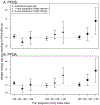Per- and Polyfluoroalkyl Substance Exposure, Gestational Weight Gain, and Postpartum Weight Changes in Project Viva
- PMID: 32959518
- PMCID: PMC7513422
- DOI: 10.1002/oby.22933
Per- and Polyfluoroalkyl Substance Exposure, Gestational Weight Gain, and Postpartum Weight Changes in Project Viva
Abstract
Objective: The purpose of this study was to test the extent to which pregnancy per- and polyfluoroalkyl substance (PFAS) concentrations were associated with gestational weight gain and postpartum weight changes.
Methods: This study was composed of 1,614 women recruited between 1999 and 2002 via the Project Viva cohort with pregnancy plasma concentrations of six PFAS, including perfluorooctanesulfonic acid, perfluorooctanoic acid (PFOA), and 2-(N-ethyl-perfluorooctane sulfonamido) acetic acid. Gestational weight gain was defined as the difference between last pregnancy weight and prepregnancy weight, 1-year postpartum weight retention as the difference between 1-year postpartum weight and prepregnancy weight, and 3-year postpartum weight change as the difference between 3-year postpartum weight and prepregnancy weight.
Results: During pregnancy, women gained 0.37 kg (95% CI: 0.11-0.62) more weight per doubling of 2-(N-ethyl-perfluorooctane sulfonamido) acetic acid. At 1 year post partum, women retained 0.55 kg (95% CI: 0.07-1.04) more weight per doubling of PFOA. At 3 years post partum, women gained 0.91 kg (95% CI: 0.25-1.56) more weight per doubling in PFOA. Findings were similar after adjustment for all PFAS. Other PFAS were not associated with weight changes. Postpartum associations were stronger among women with higher prepregnancy BMI. Models were adjusted for demographics.
Conclusions: Pregnancy PFAS were associated with greater gestational weight gain, weight retention, and weight gain years after pregnancy.
© 2020 The Obesity Society.
Conflict of interest statement
Figures


Similar articles
-
Per- and polyfluoroalkyl substances, gestational weight gain, postpartum weight retention and body composition in the UPSIDE cohort.Environ Health. 2023 Sep 2;22(1):61. doi: 10.1186/s12940-023-01009-3. Environ Health. 2023. PMID: 37658449 Free PMC article.
-
Pregnancy Per- and Polyfluoroalkyl Substance Concentrations and Postpartum Health in Project Viva: A Prospective Cohort.J Clin Endocrinol Metab. 2020 Sep 1;105(9):e3415-26. doi: 10.1210/clinem/dgaa431. J Clin Endocrinol Metab. 2020. PMID: 32620010 Free PMC article.
-
Per- and polyfluoroalkyl substance mixtures and gestational weight gain among mothers in the Health Outcomes and Measures of the Environment study.Int J Hyg Environ Health. 2021 Jan;231:113660. doi: 10.1016/j.ijheh.2020.113660. Epub 2020 Nov 9. Int J Hyg Environ Health. 2021. PMID: 33181449 Free PMC article.
-
Maternal Plasma per- and Polyfluoroalkyl Substance Concentrations in Early Pregnancy and Maternal and Neonatal Thyroid Function in a Prospective Birth Cohort: Project Viva (USA).Environ Health Perspect. 2018 Feb 27;126(2):027013. doi: 10.1289/EHP2534. Environ Health Perspect. 2018. PMID: 29488882 Free PMC article.
-
Interventions including a nutrition component aimed at managing gestational weight gain or postpartum weight retention: a systematic review and meta-analysis.JBI Database System Rev Implement Rep. 2019 Mar;17(3):297-364. doi: 10.11124/JBISRIR-2017-003593. JBI Database System Rev Implement Rep. 2019. PMID: 30870329
Cited by
-
Per- and Polyfluoroalkyl Substances (PFAS) Affect Female Reproductive Health: Epidemiological Evidence and Underlying Mechanisms.Toxics. 2024 Sep 18;12(9):678. doi: 10.3390/toxics12090678. Toxics. 2024. PMID: 39330606 Free PMC article. Review.
-
Per- and polyfluoroalkyl substances, gestational weight gain, postpartum weight retention and body composition in the UPSIDE cohort.Environ Health. 2023 Sep 2;22(1):61. doi: 10.1186/s12940-023-01009-3. Environ Health. 2023. PMID: 37658449 Free PMC article.
-
Early-pregnancy per- and polyfluoroalkyl substances and maternal post-pregnancy weight trajectory.Obesity (Silver Spring). 2025 Apr;33(4):807-816. doi: 10.1002/oby.24250. Epub 2025 Mar 12. Obesity (Silver Spring). 2025. PMID: 40074682
-
Per- and Polyfluoroalkyl Substances (PFAS) Mixture during Pregnancy and Postpartum Weight Retention in the New Hampshire Birth Cohort Study (NHBCS).Toxics. 2023 May 10;11(5):450. doi: 10.3390/toxics11050450. Toxics. 2023. PMID: 37235264 Free PMC article.
-
Imputation of Below Detection Limit Missing Data in Chemical Mixture Analysis with Bayesian Group Index Regression.Int J Environ Res Public Health. 2022 Jan 26;19(3):1369. doi: 10.3390/ijerph19031369. Int J Environ Res Public Health. 2022. PMID: 35162406 Free PMC article.
References
-
- Rooney BL, Schauberger CW. Excess pregnancy weight gain and long-term obesity: one decade later. Obstet Gynecol 2002;100:245–52. - PubMed
-
- Kew S, Ye C, Hanley AJ, et al. Cardiometabolic implications of postpartum weight changes in the first year after delivery. Diabetes Care 2014;37(7):1998–2006. - PubMed

